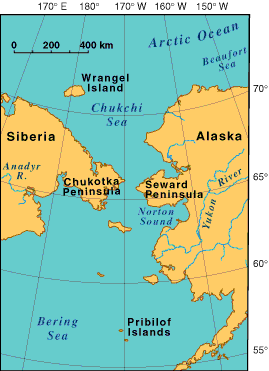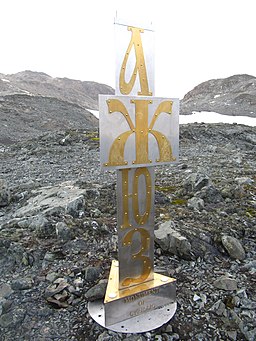Indigenous Siberia: the Chukchi Language
A few years ago I ended up composing this tiny little “article” about the Chukchi language and people. It was one of my first articles and it’s just about as God-awful as you’d expect. To show you just how awful, I’ve taken a screenshot of the article and published it here as an image…
![]()
That’s the whole article, and a reasonable tl;dr 1. The article was fewer than 250 words long and it fits inside this one like an ugly Matryoshka doll.
It’s always fun to look back on old articles and be terrified by how awful things were then, and how far you’ve come since.
This post has been silently nagging me for years – existing in a state of unread torpor while simultaneously popping up every so often to remind me that it needs to die once and for all.
But since I don’t like to let any writing die, I thought I’d just give it a huge face lift, offer some new content, explain how terrible a place Siberia is and still satisfy my need to discuss random languages you’ve never heard of, nor will ever likely hear of again.
So, let’s get into it.
Language in Siberia
Russia is possessed of a delightful number of languages, including about 35 “major” recognized languages and over 100 minority tongues and countless more regional dialects.
Until the fiery collapse of the Russian Empire in the early 20th century, Russian was the predominant and essentially only formally recognized language. After the communist Soviet Union emerged kicking and screaming from its ever so bloody, revolutionary womb, it went on to help some of the minority languages throughout the country become a bit more accepted. These efforts led to a certain degree of revitalization among tongues such as Tuvan and Chukchi.
Before its fall, the government of the USSR set about helping many of these smaller languages develop their own writing systems, many of which did not have them prior, in an attempt to bring everyone into the same fold. Most of these are based on the Cyrillic alphabet, but a certain degree of “customization” was required in order to properly suit these languages’ phonologies. These customizations included the creation of characters that are suited to Cyrillic but do not exist in Russian itself.
Some of the largest Slavic 2 alphabets look something like this disaster of a diagram:

There are many other languages that use the Cyrillic alphabet, they simply didn’t make the list because it’s already a total clusterfuck. These include Chukchi, Abkhaz, Aleut, Chuvash and several others. 3
Furthermore, Kazakh has long used the Cyrillic script, but is slated to switch to a Latin-based script by 2025.
A mistake I myself sometimes inadvertently make is associating Cyrillic with Russian above other languages as sort of the Slavic default just because it’s the biggest. By all means, Ukrainian isn’t weird and isn’t an “offshoot” of Russian so much as it is a sibling with its own quirks and, admittedly often linked, history. For all intents and purposes, it is just as much Cyrillickish as Russian or any other language that uses the system.
Despite it not belonging to Russian any more than Latin belongs to English, Cyrillic still remains linked primarily to Russian in the collective mind.
Fun fact: Russia built a monument to Cyrillic in Antarctica:
Image: Inoceramid bivalves CC BY-SA
Much like this ugly statue, languages are linked to places. In order to understand the people, their culture, and what made this language what it is today, we need to travel to Siberia.
What even is Siberia, anyway?
You’ve undoubtedly heard of the place before, but have you ever stopped to think about where it is specifically, or what you might actually find there? Do you view it as an arctic wasteland? A dense, forested plain? A zoo for huskies and reindeer?
It’s actually sort of all of these things and more.
Siberia comprises the vast majority of the former USSR and present day Russia, and is home to the bulk of the country’s minority languages and dialects, despite being home to a stunning minority of its people.
The Chukchi people
The Chukchi people are indigenous to the far northeastern parts of Russia, in particular, the Chukotka Peninsula and around the Chukchi and Bering Seas.

Their origins are tricky to trace because for the majority of history, the Chukchi people have maintained an oral tradition. Despite one or two weak attempts by Russian researchers, they didn’t have a real writing system until the 1930s. Furthermore, Russia wasn’t always fun to work with for non-USSR linguists, who are rather tight-lipped or dead.
But fortunately, the Chukchi are related to other regional groups such as the Koryak people, and their language is a member of the small Chukotko-Kamchatka language family, which is naturally comprised of sub-branches; Kamchatkan and Chukotkan languages. Go figure.
Russians first came into contact with them during the 17th century, leaving them alone for the most part because they didn’t really seem to be in the way of anything important, and were frustratingly warlike. Several decades later, when Russia wanted to set up better communications between East and West, establish trade routes and generally try to get around what they considered to be their land, the pesky Chukchi people, who annoyingly disagreed with being conquered, started interfering violently with their operations and Russia decided they had to be put down.
Unfortunately for the Russians, that wasn’t as easy as they had expected.
After a protracted, bloody conflict that occurred on and off between the beginning and middle of the 18th century, in which the Russians got pretty rapey, murdery, and reindeer-stealingy, the Chukchi ultimately sort of came out the Pyrrhic victors, having killed a bunch of important Russian military leaders, and generally making them realize that it really just wasn’t worth it financially.
Following that, they were more or less left to their own devices, eventually trading and interacting peacefully. Everyone was happy.
Today, the Chukchi people live in Chukotka Autonomous Okrug, the least densely populated administrative region in Russia and the closest chunk of Russian land to the United States, and are considerably less angry, stabby and arrow-shooty.
The broader Chukchi ethnic group is broken into two smaller groups known as the Chavchu and the Anqallyt. The Chavchu are reindeer herders who live inland, ranching on the peninsula’s tundra, whereas their maritime cousins, the Anqallyt, subsist by hunting large marine mammals along the region’s frigid coast.
Chukchi as an endangered language
Chukchi and Kamchatkan are both categorized as a severely endangered languages. The former maintains some 5,000 remaining fluent, native speakers – not even a third of the total Chukchi ethnic population, which is estimated to be around 16,000 as per Russia’s 2010 census.2
The Chukchi language is actually the most widely spoken in the Chukotkan language branch. Its siblings include Kerek (extinct), Koryak (1665 speakers) and Alyutor (25 speakers).
The language’s decline can, as with most endangered languages, be attributed to the long established but still growing prevalence of the country’s largest language, in this case Russian, particularly among the younger generations who need to be able to assimilate with a globalized world and interact within a predominantly Russian speaking country. The public education system in Russia is, surprise surprise, primarily in Russian, making it a more attractive choice when it comes to finding work, traveling, or generally doing anything that doesn’t involve reindeer, seals or being cold.
However, despite remaining in a semi-critical condition, Chukchi has enjoyed something of a small revitalization in recent years, and Chukchi language schooling has started to make a small comeback.
In the 1930s, the Soviet Union began introducing orthographic systems (writing) to its numerous Siberian and other indigenous groups. As we said above, in 1932, Chukchi adopted an alphabet based on the Latin script, which was quickly replaced a few years later by Cyrillic, due to the latter’s standardization throughout the Union, because Russia gonna Russia.
Since then, Chukchi’s writing system has continued to evolve in order to meet the needs of its speakers, even as recently as 1996, when an adorable tail was put on their Ӄ.
So it’s always nice to see that it isn’t always doom and gloom for this endangered languages. Chukchi is enjoying a slow but steady revival in the region due in part to the Russian government’s newfound interest in promoting its cultural heritage, as well as a surge in tribal pride. This has led to an uptick in the availability of Chukchi language resources in schools, such as proper language instruction and textbooks like this thing:
![]()
Currently, the Chukchi language is being used at a number of schools as the primary language of elementary education, followed by dual-language coursework alongside Russia in secondary schools. In addition to this, radio stations have begun popping up in Chukchi, and now that a standardized orthography exists, even subtitled television has begun broadcasting. Admittedly, this is less ideal than actual Chukchi language productions, but baby steps are in order, I suppose.
If you’d like to hear what the language sounds like, you should absolutely hear the beginning of this painfully adorable intro to Chukchi. They then start reading from the New Testament, which isn’t totally unsurprising:
Goat sounds delicious.
Conclusion
Why did I single out this one random Siberian language to dedicate so much time and effort to? I have no idea. I wrote about it 5 years ago back when I had no idea what I was doing and just wanted to write about random endangered languages, so I spun the globe with my finger on it stopped in Siberia.
Chukchi is a pretty awesome language, especially to listen to. More seriously, it is one of my goals to help bring languages such as Chukchi and Kamchatkan and the people who claim them as their own out of global obscurity. The language revitalization process can be controversial at times, and I myself have mixed feelings about the methods and reasoning behind some efforts.
Often, I believe that a language’s survival is largely dependent on the people who claim it as their own. It seems weird to have a bunch of New York City hipsters learning the language specifically to carry on the culture of a people a world away, no? On the other hand, New York City hipsters taking an interest in a language like this can further help the people themselves develop more and more media and “relevance” where they live, so it cuts both ways.
The good news is that either way, things are on the mend for Chukchi, even if progress is slow.
If you would like to learn more about the Chukchi people, check out this book of tales from the Alaska-Siberia Research Center.
Header image by Наталья Коллегова from Pixabay
Apex-editor of Languages Around the Globe, collector of linguists, regaler of history, accidental emmigrant, serial dork and English language mercenary and solutions fabricator. Potentially a necromancer. All typos are my own.
